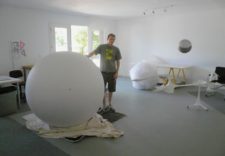
Russell Crotty
American, 1956-
Nightfall Matilija Wilderness, 2007-2019
Ink and watercolor on paper on fiberglass sphere
24 in. diameter
Russell Crotty studio

"With its patient craftsmanship and ardent attention to detail, Crotty's conscientious fusing of art and science brings honor to both disciplines. Walking through his maze of cosmic spheres, it is difficult not to feel infected by his eager fascination." - Holly Myer, Los Angeles Times

COMMENTS
Since the early 1990’s, Russell Crotty has made important contributions to contemporary drawing. Utilizing ballpoint pen as his primary medium, he is especially renowned for his distinctive drawings on paper-coated suspended globes and within large-scale books. His work engages astronomy, landscape, mapping, surfing, coastal studies, along with an idiosyncratic commentary on the natural and man made worlds. Crotty ambitiously broadens his vast body of work by incorporating bio-resin, collage, and non-traditional materials, exploring new ideas that investigate and expand the notion of “works on paper.”
As a serious amateur astronomer, Crotty has studied the night sky for decades, utilizing his own array of telescopes with occasional sojourns to professional observatories. He has made important observational contributions to accredited astronomy organizations such as NASA and ALPO (Association of Lunar and Planetary Observers). Utilizing his own array of telescopes, along with several opportunities to observe at professional observatories, he studies the stars as the 19th century astronomers did – through the viewfinder, not through digital imaging devices. His obsessive documentation of celestial phenomenon has resulted in a body of astronomical work informed by actual scientific theoretical research and infused with his own interpretations.
The evolution of this work began with flat drawings of stars and deep sky objects, often within a circular motif, as you would see it through the telescope's viewfinder. It was a natural progression for the drawings to move from circular to spherical and in the late 1990's, Russell began creating his signature globe drawings, introducing three-dimensional sculptural elements into his work.
Soon after, he began adding text to the drawings, a particular sort of prose which he refers to as "bad poetry." The text depicts his personal commentary and adds a visual texture to the landscape.
The globes are fabricated in fiberglass then covered with archival paper by professional paper conservators. Russell draws directly onto the coated globe with a special archival ball-point pen over a wash of watercolor, then a sealant is applied. Globe sizes range from 8 inches to 72 inches in diameter.
http://www.russellcrotty.com/
Origins
Crotty's work had its beginning in his childhood. His father, Harry, was a sculptor; his mother, Jean, was a ceramist and jeweler. Crotty grew up in Northern California in a milieu of artists and poets. "I always knew I wanted to be an artist," he recalls. "My father used to give me 500 sheets of paper a month, and I would go through them doing drawings."
At 13, Crotty started surfing. The following year, he was diagnosed with juvenile diabetes and confined to his bed for periods of time. He escaped into his imagination by drawing cartoon-like scenarios with surfer characters and beach settings.
Around the same time, his father died of a heart attack. To distract Crotty from his grief, his mother bought him a 6-inch reflecting telescope made by Criterion, and he soon was involved in the school astronomy club. These youthful passions were forgotten when he attended the San Francisco Art Institute where he graduated with honors and a bachelor's degree in fine art in 1978. After completing the University of California, Irvine, graduate degree program in 1980, he moved back to Northern California. In 1984, he moved to Los Angeles to join its vibrant contemporary art scene.
From Surfing to Stars
Between 1990 and 1993, Crotty's ballpoint pen drawings of surfers on wall-size grids gained the attention of critics. Ironically, moving to Malibu, where he could look at the coastline all day and surf whenever he desired, dampened his drive to continue those drawings. One night, he stepped onto the front porch and looked up to see a crystal necklace of stars and planets arrayed on velvet darkness. "It was like 'Aha!'" he recalls. "I knew I could make work out of that for a long time."
Crotty was familiar with the positions and appearances of stars and planets. He could identify Jupiter in the constellation Leo by its brilliance, for instance. To construct accurate representations of the universe, the artist learned how to make scientifically accurate visual observations and detailed annotations. "It was a challenge for me, a discipline I needed," Crotty says.
Once prepared mentally, he built a corrugated metal shed about 500 feet from the house. Crotty commissioned Ed Grissom, a well-known local amateur astronomer, to build a telescope facing away from the lights of Los Angeles and toward the deep, black sky over the ocean. Solstice Peak Observatory, as Crotty calls it, cost him about $3,000 and houses his 10-inch f/8 Newtonian reflector on a proudly non-computerized, dual-axis parallax drive. Crotty also started attending star parties with fellow amateur astronomers on Mt. Pinos in the Los Padres National Forest in southwestern California, far from any city lights and perfect for stargazing.
Global Matters
As the millennium approached, Crotty started drawing on paper-covered Lucite globes between 3 and 4 feet in diameter. For example, on one three-dimensional version of Earth, he renders the horizon as seen from Malibu in dark silhouette, backlit by the reflected light of the city. The skies are tethered to man-made manifestations of architecture as well as to spiky stands of pine and oak.
Visual observation of the stars dates to the Neolithic Age, but astronomers now rely more on computers to assist with their searches of the night sky. Crotty does not depend on computers to make his observations. Instead, his knowledge and interest drive each of his four scopes -- including the reflector from his childhood. He is committed to astronomy of the 19th century, when the discipline was suffused with romance and mystery. "I like being out in the cold, with my paper on a clipboard, making drawings of planets," he says. Lately, he's concentrated on observing double stars and enjoys the challenge of splitting them.
He makes straight scientific illustrations that serve as departure points for his artwork. He focuses on the circle format that gives viewers the impression of looking through the eyepiece of a telescope, a point of view that includes them in the experience of discovery.
He spends the nocturnal hours in his observatory, making painstaking drawings illuminated by a tiny flashlight held in his mouth. Back in the studio, he expands and alters these firsthand impressions. What he sees through the telescope each night, he says, is "where it all begins."
- Hunter Drohojowska-Philp, Drawing the Universe, Astronomy, Dec. 2004, Vol. 32 Issue 12, pp. 90-91
SBMA CURATORIAL LABELS
As an amateur astronomer, artist Russell Crotty has spent decades observing the night sky and meticulously mapping constellations through his prolific body of drawings. Rather than relying on digital imaging technology, Crotty studies the stars as 19th-century astronomers did through telescopes and professional observatories. His signature globes, like this one, evolved from this practice of direct observation starting in the late 1990s. The fiberglass globes are covered in archival paper upon which he methodically articulates stars and landscapes with ballpoint pen and washes of watercolor. By transforming his drawings into sculptural orbs, Crotty effectively creates inverted planetariums in which the night sky is turned in on itself, playing with scale and perspective and reminding us that the cosmos is not a flat pictorial backdrop but rather a three-dimensional realm in which we are adrift.
- The Observable Universe: Visualizing the Cosmos in Art, 2019
